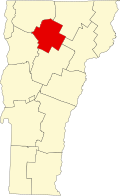Geography
Wolcott is the easternmost town in Lamoille County. It is bordered to the northeast by Orleans County and to the southeast by Caledonia County. The Lamoille River crosses the southern part of the town from east to west, followed by Vermont Route 15, which leads northwest 8 miles (13 km) to Morrisville and southeast 6 miles (10 km) to Hardwick. The unincorporated village of Wolcott is in the southern part of the town, along Route 15.
According to the United States Census Bureau, the town of Wolcott has a total area of 39.2 square miles (101.4 km2), of which 38.8 square miles (100.5 km2) are land and 0.35 square miles (0.9 km2), or 0.88%, are water. [1]
Demographics
Historical population| Census | Pop. | Note | %± |
|---|
| 1790 | 32 | | — |
|---|
| 1800 | 47 | | 46.9% |
|---|
| 1810 | 124 | | 163.8% |
|---|
| 1820 | 123 | | −0.8% |
|---|
| 1830 | 492 | | 300.0% |
|---|
| 1840 | 824 | | 67.5% |
|---|
| 1850 | 909 | | 10.3% |
|---|
| 1860 | 1,161 | | 27.7% |
|---|
| 1870 | 1,132 | | −2.5% |
|---|
| 1880 | 1,166 | | 3.0% |
|---|
| 1890 | 1,158 | | −0.7% |
|---|
| 1900 | 1,066 | | −7.9% |
|---|
| 1910 | 1,049 | | −1.6% |
|---|
| 1920 | 932 | | −11.2% |
|---|
| 1930 | 831 | | −10.8% |
|---|
| 1940 | 772 | | −7.1% |
|---|
| 1950 | 766 | | −0.8% |
|---|
| 1960 | 633 | | −17.4% |
|---|
| 1970 | 676 | | 6.8% |
|---|
| 1980 | 986 | | 45.9% |
|---|
| 1990 | 1,229 | | 24.6% |
|---|
| 2000 | 1,456 | | 18.5% |
|---|
| 2010 | 1,676 | | 15.1% |
|---|
| 2020 | 1,670 | | −0.4% |
|---|
|
As of the census [2] of 2000, there were 1,456 people, 552 households, and 401 families residing in the town. The population density was 37.3 people per square mile (14.4/km2). There were 646 housing units at an average density of 16.6 per square mile (6.4/km2). The racial makeup of the town was 98.83% White, 0.07% Black or African American, 0.27% Native American, 0.07% Asian, 0.14% Pacific Islander, and 0.62% from two or more races. Hispanic or Latino of any race were 0.34% of the population.
There were 552 households, out of which 39.9% had children under the age of 18 living with them, 58.2% were married couples living together, 7.4% had a female householder with no husband present, and 27.2% were non-families. 18.8% of all households were made up of individuals, and 5.8% had someone living alone who was 65 years of age or older. The average household size was 2.63 and the average family size was 2.99.
In the town, the population was spread out, with 28.4% under the age of 18, 7.3% from 18 to 24, 34.0% from 25 to 44, 23.4% from 45 to 64, and 6.9% who were 65 years of age or older. The median age was 33 years. For every 100 females, there were 105.6 males. For every 100 females age 18 and over, there were 102.3 males.
This page is based on this
Wikipedia article Text is available under the
CC BY-SA 4.0 license; additional terms may apply.
Images, videos and audio are available under their respective licenses.




